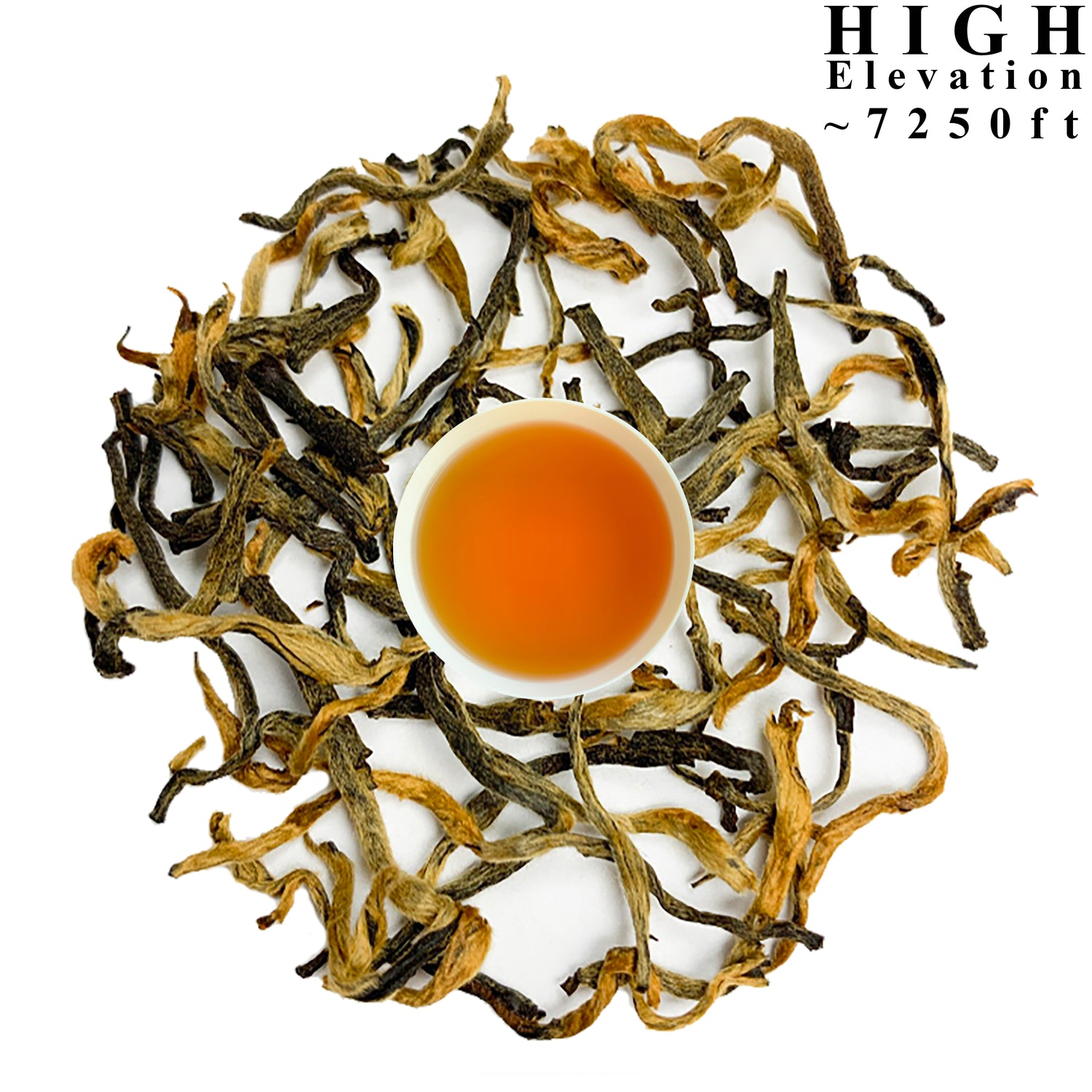
Black Teas: Everything You Need to Know
If you are a tea lover, there is a very unlikely chance that you have not tried black tea.
Black tea is the king of tea when it comes to popularity as it is the most commonly consumed tea all around the globe. From Asia to Europe, Africa, and America, people have shown great admiration for black tea for its boldness and strong flavor. Many guess that tea leaves for black must be different from other tea leaves as they have a stronger flavor than others. Don’t be surprised to learn that tea leaves for black tea also come from the same plant as others - Camellia Sinensis.
What exactly is black tea?
When you find people offering you tea, they are most probably referring to black tea. So, what is black tea? Black tea got its name from its dry dark-colored leaves. However, in China, they call it red tea for its reddish infusion. Black tea comes from the Camellia sinensis plant, the same as other teas. What makes it different is its unique, bold, and strong flavor. So, what is the reason for black tea leaves to provide such an intense flavor? Well, the reason is hidden in its production process. Unlike other teas, black tea leaves are fully oxidized before processing and the darkness of the tea depends on the length of the oxidation process.
There is no specific time for enjoying black tea, you can enjoy it at any time of the day depending on your mood. What is black tea good for that it is much loved? You must probably know if you have ever tried taking a cup of tea when you are feeling tired or stressed. It must have awakened your mind and refreshed you. However, mental alertness is not only the benefit of consuming black tea, you are also doing your health a great favor by consuming it. Black tea contains useful antioxidant substances that are very helpful in protecting your blood vessels and maintaining healthy blood pressure. The research also shows that black tea reduces the risk of life-threatening health diseases like cancer and stroke. This is enough for people to fall in love with black tea.
However, be careful to consume black tea at a limited level. We would recommend not drinking more than 4 cups of black tea in a day as it contains caffeine. Do you enjoy making tea from black tea bags or loose tea leaves? The good news is that both are easily available in the market. It is always better to go for loose tea leaves for the best flavor and benefits.
Is black tea just red tea?
Black tea and red tea create confusion most often. In the West, the name of the tea is given after the color of the leaves. So, western countries refer to it as black tea considering the color of black tea leaves. But it is different in the east. Unlike the West, China refers to tea considering the brewing color. They call it red tea as tea has a reddish brew. So, be careful when buying products from the store. Consider the location of the store and production place of the tea before buying the tea to eliminate confusion.
History of British Black Tea
Black tea first originated in China during the 17th century. After the discovery of black tea, it became an instant hit for its characteristics of being flavorful for an extended period. It did not take long to attract British traders. They reacted immediately and began purchasing the black tea considering its awesome benefits. However, they were unfortunate to see the Dutch taking over the whole market soon after. The Dutch takeover of the market left the British traders disappointed and they began to search for alternative ways for getting their hands on black tea. With continuous research, they got lucky to discover similar types of Camellia Sinensis plants in India, a nearby country to China. It was like winning a lottery for the British as the plant contained more caffeine that could produce a more intense flavor.
As we dive into the black tea history in Britain, it is seen why it used to be called a high-class drink. During the beginning days of British black tea, the price was very high and only the rich could afford them. As a result, the people considered to be elites only could enjoy tea then.
The British palace got its first black tea from Princess Catherine. After the introduction of tea to the British royal family, it did not take long for the tea to win the hearts of the people inside and as a result, it became a close part of the British royal tradition.
As the production rate gradually increased, it eventually saw a downfall in the prices of black tea. The tea was then within the reach of the general public as it was affordable for them. It began the tradition of consuming black tea as afternoon tea in Britain.
As they consumed the tea more often, they started to love it and its affordable price led to tea brewing in the morning as well as evening.
How is black tea made?
The bold flavor of black tea depends on the way they are produced.
Let's take a tour of the black tea production process, we are sure this is going to be an exciting journey for you.
Picking
Yes, you guessed it right. It all begins with picking up the black tea leaves.
Ever heard about “tea fields”? We are sure the large area full of tea plants appears in your mind when you hear this. In this process, the top juicy and young leaves with a small portion of steam from a tea plant are picked by hand. Note that not all entire plants are harvested at a time.
Withering
The harvested tea leaves are spread on the wooden surface to make them dry. Balanced sunlight and air are required, so it is generally done outside. It can also be done inside, however, it is important to make sure that humidity and temperature are controlled well. The process is usually completed in 10 to 14 hours.
Rolling
This step is very vital for achieving the color and flavor of black tea. The tea leaves are broken so that their oil and enzymes are exposed to the flow of air resulting in a chemical reaction to achieve the flavor in the tea.
Oxidization
Once the rolling process is completed, the oxidation process is immediately activated. No extra activities are carried out as the black tea plant leaves are just let to rest for around eight hours. The tea plant leaves get their dark brown color in this phase.
Drying
This is the final stage where well-oxidized black tea leaves are left to dry so that any remaining moisture is removed. Different methods can be used for drying the plant. Pan drying and oven drying are to name a few. The typical temperature for drying is 175 degrees Fahrenheit to 195 degrees Fahrenheit as the process is completed in around 20 minutes. Carelessness could result in burning in the tea leaves, so high attention is required.
Types of Black Teas
As a tea lover, you might already be familiar with black tea like Earl Grey, English breakfast tea, and iced tea. But the list does not end here, there are many more to explore. We have created a list of some of the popular types of black tea and we are sure that old tea lovers as well as new ones will be delighted to learn about the black tea variety.
Golden Tips Tea
Exclusive Golden Tips Shangri-La teas are a rare type of tea from the Eastern Himalayas in Nepal. The teas are selectively harvested as soon as the new buds are seen on the plant which contributes to a distinctive taste and flavor in a tea. The gold-colored buds and green-brown leaves provide your tea with attractive eye-appealing caramel colored once steeped. With mild creaminess and smooth texture, Golden Tips Shangri-La Black tea is a tea for people who love a thick consistency in their beverage. Alongside taste and flavor, if your priority is a beverage full of nutrition and minerals, then no look other than Exclusive Golden Tips Shangri-La black tea.
Ilam Black Tea
The teas that are grown in High hilly and Himalayan regions always have the finest quality. Illam black tea from the Tea Mountains of Nepal is the black tea for you if you love your black tea strong and rich in flavor. The avocado-brown and green colored leaves produce light caramel and apricot orange color after steeping; the eye-catching color only adds more value to the tea.
Keemun
Inquiry for the top 10 tea list from China, and you will find Keemun black tea on the list for sure. This is the only black tea to make it to the list.
Once brewed, the tea produces a rich reddish brown color with a mellow taste with a toasty flavor. There is no sign of bitterness; you can enjoy it with baked foods like bread or muffins.
Mt. Pumori Gold Black Tea
Pumori gold black teas are yet another high-quality tea from the Himalayan country Nepal. The use of the young leaves and downy buds is the reason for the unique maple syrup taste. As you steep the brown leaves, it produces caramel brandy amber-colored tea with fruity notes.
Assam Black Tea
Assam black tea comes from Assam, the largest tea-growing region by production. With its bold and malty flavor, Assam tea is popular as one of the strongest black teas in the world. The brewed tea with a rich golden color provides spicy and earthy notes.
Ceylon Black Tea
As Sri Lanka is the place of origin for tea, Ceylon black tea is also popular as Sri Lankan tea. Ceylon tea with bold and floral notes produces light golden reddish color after brewing and the taste is most often described as sweet and a little citrusy.
Notes about Black Tea Tasting
With the growing popularity of black tea, many tea lovers feel that their day is incomplete without drinking black tea at least once a day. However, people also consider various factors before selecting the best tea for them as the demand for different varieties and flavors has increased remarkably.
If you are tasting black tea, then the common fact to remember is that black tea flavors are bolder and stronger than almost all other types of tea. However, each type of black tea has its unique flavor depending on the climate of the cultivation place, the technique of fertilization, and the process of production.
The most common appearances you get after brewing black tea are red, dark brown, and light brown color. People usually describe black tea as being citrusy, fruity, sweet, or smoky. Remember, black tea tastes highly dependent on the way they are oxidized.
The Caffeine Content in Black Tea
Black tea typically has a higher caffeine content than other tea. Black tea’s caffeine content depends on many factors from the types of tea (broken or non-broken), to the brewing process (the longer you steep your tea, the more caffeine you will get in your cup of tea). Generally, black tea contains 64 to 112 milligrams of caffeine in one cup (8 oz.).
Conclusion
With Danfe tea, you can always expect high premium quality tea. Black tea from Nepal always has a unique fragrant flavor, thanks to the fitting climate and temperature.
Not a fan of the high bitter taste in black tea? The Himalayan tea from Danfe will change the way you view the taste of black tea.
Danfe Tea brings you the finest loose leaf tea from the Himalayas. With over 30 natural loose-leaf tea variants, we offer 1 lb variants and also offer monthly tea subscription.










